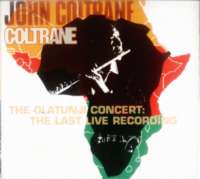The Olatunji Concert: The Last Live Recording
| The Olatunji Concert: The Last Live Recording | |
|---|---|
 | |
| Live album by John Coltrane | |
| Released | 2001 |
| Recorded | April 23, 1967, Olatunji Center of African Culture, New York City, New York, United States |
| Genre | Free jazz |
| Length | 63:38 |
| Language | Instrumental |
| Label | Impulse! |
| Producer | Bryan Koniarz |
| Professional ratings | |
|---|---|
| Review scores | |
| Source | Rating |
| Allmusic | |
| Pitchfork Media | 10[2] |
The Olatunji Concert: The Last Live Recording is the Impulse! Records-released final live recording of saxophonist John Coltrane, recorded April 23, 1967, at the Olatunji Center of African Culture in New York and released posthumously on Compact Disc. The album consists of two songs—"Ogunde", which Coltrane also recorded for his final self-approved album, Expression, and an especially free-form "My Favorite Things", which Coltrane had performed live regularly since 1960. The recording was done for broadcast on Billy Taylor's local radio station, WLIB.
On the recording, Coltrane and Pharoah Sanders performs intense and lengthy, though poorly recorded, solos. Sonically, the album is notable for its overwhelming din of multiple drummers.
About a month after this show, Coltrane began to complain of intense abdominal pain; he died two months after that, in July. The Olatunji Concert was not Coltrane's last show, but rather, his penultimate—he would play one more on May 7, 1967, in Baltimore.
Track listing
| No. | Title | Length |
|---|---|---|
| 1. | "Introduction by Billy Taylor" | 0:35 |
| 2. | "Ogunde" (John Coltrane) | 28:25 |
| 3. | "My Favorite Things" (Rodgers and Hammerstein) | 34:38 |
Personnel
- John Coltrane – soprano and tenor saxophone
- Rashied Ali – drums
- Alice Coltrane – piano
- Algie DeWitt – Batá drum
- Jimmy Garrison – double bass
- Pharoah Sanders – tenor saxophone
- Juma Santos – percussion (possibly)
References
- ↑ Samuelson, Sam. The Olatunji Concert: The Last Live Recording at AllMusic. Retrieved February 9, 2012.
- ↑ Buckman, Luke (October 15, 2001). "John Coltrane: The Olatunji Concert: The Last Live Recording | Album Reviews". Pitchfork Media. Retrieved February 9, 2012.